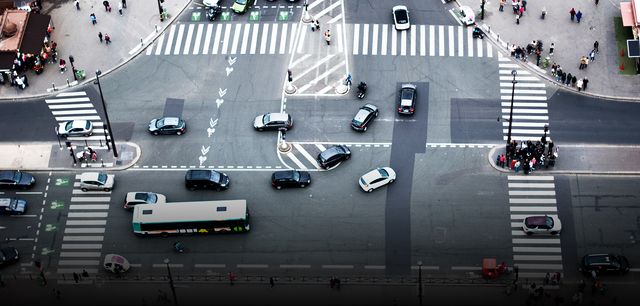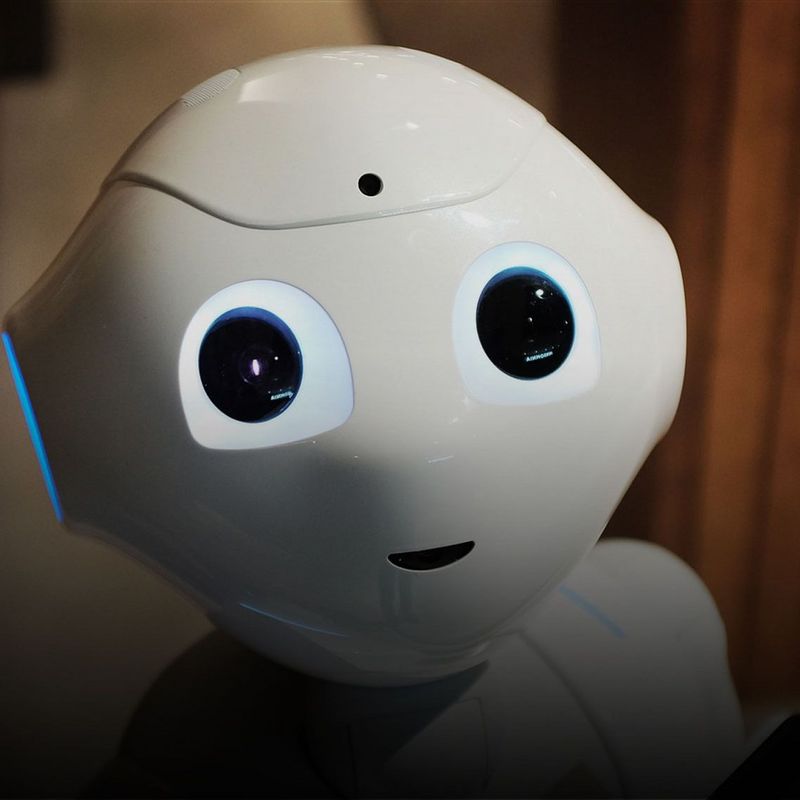28. October 2021
Reducing delays, predicting pollution, controlling traffic lights more intelligently – how Artificial Intelligence is making traffic smoother, safer and cleaner.
AI for more punctual trains
Travelling by train is good for the climate, but delays are bad for the nerves. To keep the latter at the lowest possible level, Deutsche Bahn, Germany’s main rail services provider, has programmed in some digital support. On the Stuttgart local train network, AI is now supporting human schedulers in their work to manage the traffic as efficiently as possible in the event of disruption. This is intended to ensure more punctual trains and congestion-free traffic flows on busy routes. The AI-based tool calculates several possible variants of train control around 100 times faster than real time. As in a video, the traffic can be fast-forwarded and rewound and observations made as to how decisions affect punctuality. Deutsche Bahn claims that possible delays can thus be minimised, especially in the event of disruptions such as a fallen tree on the line. In Stuttgart, AI has increased punctuality by up to three percent in cases of disruption. This sounds like a fairly modest start, but DB maintains that anything up to double-digit punctuality gains would be possible in larger transport networks. The rail group accordingly wants to start using the self-developed AI tool in other local train networks before the end of this year.
Predicting pollution
The air quality in German cities has continuously improved over the past few years. Whereas the limit value for harmful nitrogen oxide was exceeded in 57 cities in 2018, according to the Federal Environment Agency there were fewer than ten remaining offenders, including metropolises such as Munich and Hamburg, in 2020. Not sufficient grounds to sound the all-clear, according to the WHO, which recently recommended significantly stricter limit values. The KISP research project aimed to find out whether AI could be recruited to predict these nitrogen oxide loads. Weather data, traffic information and values from pollutant measuring stations were compared using AI and tested for correlations. The researchers ran the system in five German cities: according to their information, the pollutant prediction system’s hit rate was around 80 percent. This kind of forecasting system is intended to help local authorities head off the threat of borderline nitrogen oxide pollution in advance – for example, by counteracting it with the offer of discounted tickets for buses and trains.
© GettyImagesA sensor measures fine dust pollution at the Neckartor in Stuttgart - an air pollution hotspot. This could be reduced considerably with the help of AI.
Smart traffic lights in Manchester
The city of Manchester is best known outside the UK for its football clubs and as the cradle of legendary bands such as the Smiths and Oasis. But the former industrial heartland of Great Britain has once again been setting technological benchmarks in recent times: traffic in the metropolitan area is now being controlled in some places by artificial intelligence. AI sensors at junctions measure current traffic flows and can also detect the ways in which people are on the move. Pedestrians and cyclists, for example, are supposed to be given preference in the scheduling of green phases at traffic lights. When motorised traffic increases, the traffic light switching can help clear the queues, thereby reducing not only congestion times, but also the environmental impact. The plan is to digitalise a total of 23 junctions in this way by the end of this year.
The system was developed by Vivacity Labs, which has already garnered some prior experience with smart traffic lights. Until now, junctions have had to be elaborately and expensively connected with data cables. With the new systems, the sensor data are transmitted via 5G, using the mobile network. This should help reduce construction times and costs and allow the spread of smart traffic lights more quickly throughout the United Kingdom. In August, Manchester's transport authority placed an order with the company for an additional 100 AI sensor systems. The city wants to use these to determine how cycle paths and footpaths are used and also to put its further planning in these areas on a sound, database-supported footing. The city's ambitious goal is to create the UK's largest network of footpaths and cycle paths.
© ShutterstockClever traffic lights in Manchester recognise how many people and vehicles are on the road and control traffic accordingly thanks to AI sensor systems.
Navigating Ingolstadt intelligently
Thanks to AI, traffic in Ingolstadt, Germany, is also set to flow more smoothly in the future. The KIVI project launched in October, where KIVI stands for the German equivalent of “Artificial Intelligence in Ingolstadt’s Transport System” – aims to collect and evaluate data from road users over the next three years and explore the potential of AI in pilot projects. This will for the first time combine different and, in some cases, new data sources: from vehicle fleets, public transport vehicles, cyclists and pedestrians. In a next step, this data will then be incorporated into the traffic light management system, for example, making traffic safer and fairer for everyone. In Ingolstadt, cameras and induction loops in the tarmac are already recording how many cars and buses are currently waiting at any given intersection. Green- and red-light phases are then either extended or shortened accordingly. Buses automatically get an “unconditional green light”, which does, however, slow down the motorists. The idea is to use AI to achieve the fairest possible balance. The federal government is funding KIVI to the tune of 6.9 million euros; the city is contributing a further 1.7 million. If the AI projects and measures are successful, they will be rolled out throughout Ingolstadt in the medium term.
The "KIVI" project was recently launched in Ingolstadt. Data from all road users is collected and leads to AI pilot projects that are intended to regulate traffic more efficiently.
AI bollards in Karlsruhe
Anyone who drives along Zirkel-Strasse in Karlsruhe will eventually run up against the future. Even though, at first glance, it just looks like an ordinary bollard. For example, when an ambulance approaches, the metal pillar retracts into the ground by itself. Responsible for this is an inconspicuous column on the roadside which houses an AI system. This analyses the environment using multiple sensors and detects emergency vehicles such as fire engines, police cars and emergency ambulances, but also the local authority’s own security staff as well as delivery vehicles and residents – the latter being identified by their number plates. This is enabling AI to solve a specific problem: although the road has been closed to motor vehicles for years, it has still been plagued by through traffic, with the ensuing congestion, traffic chaos and danger to cyclists and pedestrians. A temporary complete closure slowed down the through traffic but also left emergency vehicles out in the cold. Thanks to the smart bollards, they now have a free pass at all times, and pedestrians can now use the road in greater safety. Further smart bollards are planned in the nearby Kaiserpassage. This has been blighted for years by “boy racers”, whose howling engines disturb the peace of passers-by and residents alike.
© iStockMulti-sensors at the roadside detect whether police cars or emergency services are approaching, then the bollards retract into the ground.







